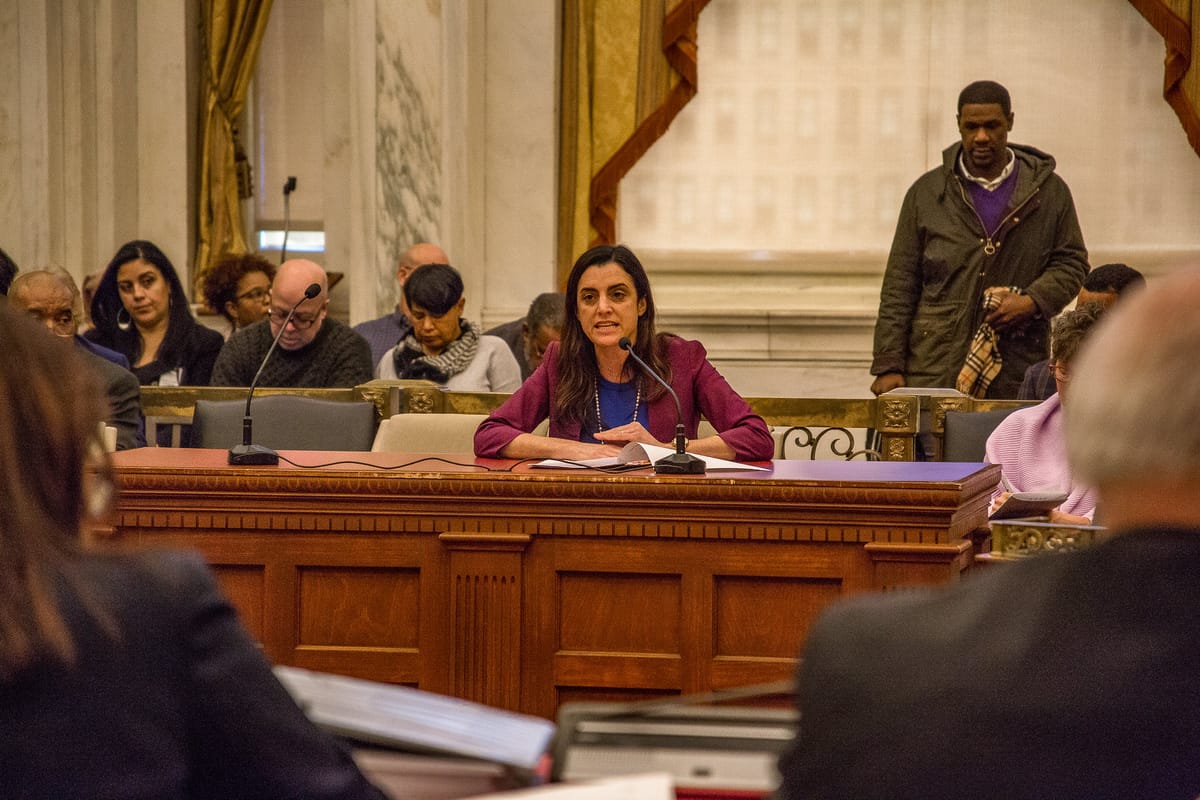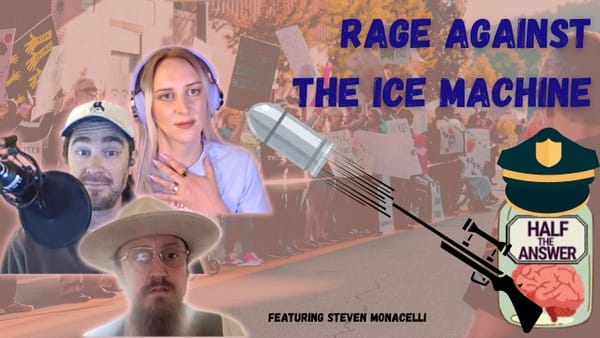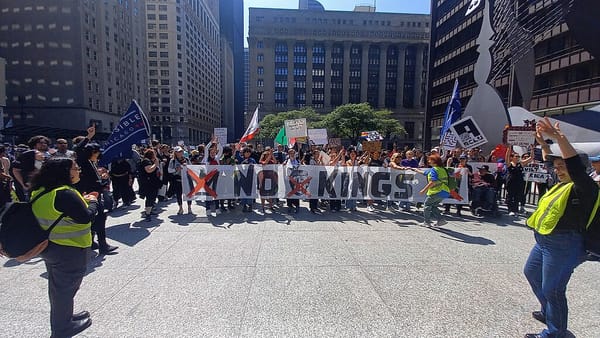How Movements Win
On the importance of a strong inside strategy.

On May 25, 2020, Derek Chauvin knelt on the back of George Floyd's neck until he died. The murder was recorded by numerous bystanders on cell phones. Protests began within hours in Minneapolis; within days, they had spread across the United States and into other countries. Depending on how you count, the protests would last for twelve months and involve between fifteen million and twenty-five million American citizens. The goal most closely associated with these protests could be heard chanted at any rally: abolish the police.
It is now not quite four years since the murder of George Floyd. The protests have faded away. The police remain unabolished. Their record of brutality and murder appears to have been little affected; if anything, the main long-term result has been a large-scale work slowdown on the part of police, leading to increased violence and murder in the communities they purportedly protect.
The George Floyd protests are not the only high-profile failure of a high-profile mass movement in recent years. Occupy Wall Street energized people across the country to overthrow the dominance of the 1%; more than a decade later there is little material change to show for it. Tahrir Square put millions in the streets and threw out Mubarak; fewer than three years later Mubarak's carbon-copy successor Sisi was again entrenched in power.
All of these movements were in practice "horizontalist," lacking leaders, organization, discipline, hierarchy. In his If We Burn, Vincent Bevins blames their failures on this fact (reviewed and discussed in these pages here). In Bevins' telling, the lack of defined leaders and organizations allowed these movements to be co-opted by better-organized and more hierarchical right-wing organizations; in Egypt the Muslim Brotherhood and shortly thereafter the military. In America these movements were not so much co-opted as outlasted—police and police unions, notably, were able to simply weather the storm of George Floyd and outlast any pressure for change.
This suggests an answer to the problem: "organize like they organize." If the right wing has disciplined and hierarchical organizations, we simply need to have our own, capable of beating them over the long haul. "Articulate our goals, organize our members, impose costs on the powerful until they accept our demands." And here is the first core claim of this essay: this won't work. Modern liberal democracies—with free speech, reasonable prosperity, relatively non-corrupt government, and ubiquitous social media—make it easier than ever for anyone to participate in politics. Paradoxically, it is this very freedom that makes it harder than ever to create disciplined political organizations.
As Mancur Olson notes, hierarchical organizations can only function when they can selectively provide rewards or punishments to their members based on compliance with the organization's goals. But this is hard to do in a modern liberal democracy! The river of money pouring through crowdfunding sites like ActBlue has created a source of funding that parties can't control, access to party organs like publications and printing presses means little when anyone can talk to everyone for the low cost of free, and if I want to leave your reading group and form my own, it's not like you can stop me—it's a free country, after all. Witness the near-total inability of the Democratic Party to bring wayward senators like Joe Manchin or Kyrsten Sinema in line: there is simply nothing the party could plausibly threaten them with. The same is true of nearly any political organization today.
But wait. Didn't I just say that police effectively organized a disciplined collective response to the George Floyd protests? They did—but they were able to do this because police are a union, and unions have unusual features that enable them to act like disciplined political organizations. Closed shop unions can selectively distribute benefits to their members, whether that's employment or legal representation. However, the structure of unions inherently limits the scope and goals of such organizations. The inherent limitations of their membership allows them to exert a great deal of pressure over their employer on specific subjects, while also tending to limit their political goals to the specific conditions of their company or industry. Thus, while unions remain a core part of progressive movements, they are unlikely to form a general model for organizing and action.
The inside/outside strategy
Hence the dilemma: if neither horizontalism nor hierarchy works, what are we left with? The dilemma is not insoluble. Recent times are not just a record of failed movements. Rather, our age has included some tremendous successes in progressive organizing. Consider the LGBTQ rights movement. Even in my own childhood, "gay" was a ubiquitous slur. Gay marriage was illegal. AIDS was a death sentence. Today, despite vicious Republican attacks on my community, queer rights are a fact of life, enshrined in law and popular opinion. Whatever the queer rights movement did, it worked. There are lessons to be learned.
The overall strategy was best theorized by ACT/UP. They called it the "inside / outside strategy." The movement had two components. The first was the outside component. This was protest, die-ins, the AIDS quilt—dramatic public acts that worked to raise awareness of the issue and create a sense of urgency—that something must be done. The inside strategy was more boring. It was the people who would show up at city hall at 3pm on a Wednesday to explain the specific policy changes they wanted to regional hospital management. Presentations to the FDA explaining the ethical calculus behind allowing AIDS patients to access experimental medicines. White papers and pocket protectors, speaking the language of policy and evidence. "Something must be done? Here is something you can do."
It is worth emphasizing here that even the outside component of this strategy was fundamentally based on persuasion. The queer rights movement did not "extract concessions" from a hostile straight elite. There are, to be blunt, not very many of us, and we are often poor and marginalized. We do not have some mass base that could bring society to a halt; indeed society spent a century grinding us down without really being too bothered about it. If we threw every one of our bodies onto the gears of an uncaring society, all we'd achieve would be some bloodstained gears and a society that kept on churning without us. Rather, the various colorful protests—and every individual act of being out and proud—served to persuade straight society that we were neither a threat nor a danger, but simply ordinary people like everyone else, looking to live our lives freely and with dignity.
And this all worked despite the fact that there was no one running the place. Yes, there are a few high-profile LGBTQ organizations such as Human Rights Watch, but they are not exactly a disciplined party that organizes and directs The Queers everywhere. Rather, the LGBTQ rights movement has since Stonewall been a chaotic mess of different factions, groups, and ideas. Discipline and hierarchy were not necessary.
The fact that a movement shaped like this succeeded is not an accident. Rather, it worked because it synergized with certain core features of modern liberal democracies. Under conditions of liberalism, strategies of extraction and coercion are difficult to implement. The state is very, very durable, and it will outlast you. The state is not composed of a brittle, exclusionary minority, ready to shatter at one blow from the disenfranchised many. Material conditions are pretty good and few people want to die for the revolution. There is a great diversity of people, identities, and opinions, not some waiting-to-be-woken-to-action 99% of homogenous thought and feeling. Fundamentally, the LGBTQ rights movement succeeded because our pitch was pretty good, and it convinced most people. The success of our movement can't be disentangled from the fact that in fact we are not rapists, perverts, and pedophiles, and that what we wanted was simply the same rights as everyone else.
Police abolition is a weak inside strategy
Now for an unpleasant assertion: this is why the George Floyd protests failed. Their cause was righteous. Their outside component was extremely strong. Their inside component was not. In the heat of the moment, in the face of a roaring crowd, they convinced a supermajority of the Minneapolis City Council to commit to abolishing the police. But once that moment had passed, once they were no longer standing at the head of a roaring crowd but sitting in some fluorescent-lit conference room, they could not persuade the council to go beyond empty slogans and actually abolish the police. The outside component was as potent as anything we've seen in decades. But the inside component could not get the movement over the finish line.
What police abolition failed to marshal was the kind of evidence that could convince the very boring ordinary elected officials on a city council to pull the trigger and abolish their police departments. They could provide stories and dreams and hopes, but little in the way of evidence that abolishing the police would lead to those dreams and not directly to vigilante killings, as it very much did at CHAZ/CHOP, and as it very much has in most other modern states that have, for one reason or another, lacked a functioning police force. The inability—and unwillingness—of police abolitionists to answer very basic questions about murder and rape, to move immediately to whataboutism did not serve them well when it came time to actually wield power.
Another unpleasant assertion. The George Floyd protests failed not because of events on the streets of Minneapolis, but in the halls of the ivory tower decades earlier. Ideas are not distilled from the air. In many cases, they are developed over decades by intellectuals and academics laboring in obscurity. The idea of abolishing the police was not invented on the streets of Minneapolis in 2021. The theory of police abolition was developed over decades by intellectuals and academics such as Angela Davis, Ruth Wilson Gilmore, Mariam Kaba, and others. These authors have done the world a profound service in making plain the abuses and failures of the American police-prison system. But they also gave us a program for change that proved unsatisfactory when it came time to enact it.
Ideas are not simply determined by material conditions. Police abolition is hardly the only solution to the problem of police brutality that has ever been proposed. There are always choices to be made, theories to be weighed, ideas that win out and ideas that lose. To return to the example of the queer rights movement, the push for marriage equality was not foreordained; there were thinkers in the movement who wanted to push for marriage abolition—notably, Michael Warner, but others as well—but these ideas lost in favor of ideas about normality and equality.
Building a good inside strategy
Hence the second core claim of this essay: if you want to win, you need to have a good inside strategy, and you need to develop it ahead of time. If you want to be ready to seize the moment when it comes—if you want to not waste a crisis—then you have to have a strong inside component ready to go when that crisis arrives. The question therefore is: what makes for a good inside strategy? And what makes for a bad one? The answer is simple, if not easy. Functional inside strategies are grounded in reality. Non-functional ones are oriented around maintaining in-group cohesion. Two examples illustrate the point.
Police abolition succeeded in capturing the imagination of leftist intellectuals not because it was sound policy based in evidence, but because it served wonderfully well to maintain in-group cohesion. Embracing the most radical position was a way to keep oneself in good odor with the rest of the crowd—and no one wanted to be a filthy liberal who hadn't gotten on board with the radical cause du jour. Thus, questions about empirical matters—like how best to reduce police brutality and corruption—were transformed into questions of group standing and moral character. If you weren't on board with the most radical proposal, then obviously you were in favor of police brutality and the system exactly as it exists.
Another way of maintaining social cohesion while retreating from reality is simply to equivocate on core terms and slogans. "Abolish the police" itself has gone through this process rather dramatically since 2021, with the slogan undergoing a complete trifurcation of meaning. When the moment came to actually seize power, police abolition had to finally directly confront the question "what do we do about the rapists and the murderers; what happens when a guy with a gun just goes house to house raping women." The hard-core police abolitionists will advise you to lie back and think of the revolution. This answer is unsatisfying to most, including most police abolitionists. The more liberal among them simply redefine abolishing the police—witness, for instance, the bizarre case of San Francisco City Supervisor Hilary Ronen claiming that she is all for abolishing the police, before immediately explaining that she just means funding social services more. The more radical instead will be quite explicit: "after we abolish the police, me and my friends with guns will simply run lynch mobs enact communal justice." By ignoring the material contradictions between these three very different policies, by hiding that disagreement under the single now-multivocal phrase "abolish the police," in-group cohesion is maintained—but only by retreating from practical politics, retreating from any situation where the material contradictions would rapidly come to the fore.
These are examples of inside strategies that serve only to maintain group cohesion instead of confronting reality and standing ready to use power. Reality means being explicit about the intended policies and providing empirical evidence to suggest that they would in fact achieve your intended goals and change things for the better. In a functional movement, the ideas that win out do so at least in part because they are based in reality, and the ideas that lose out do so at least in part because they are not.
This sounds very much like I am proposing a vacuous and individualistic solution for a systemic problem. "Just choose truth! Don't give in to group dynamics! Kill the populist in your heart!" It's therefore worth dwelling on the example of, of all things, modern science. "Science" is not some transhistorical force of nature. Science as we understand it is an idea and an institution that was developed relatively recently. Crucially, it is a self-organizing institution, one not imposed from above by some governmental authority but created by associational group dynamics that crossed the lines of existing institutions and even national borders and all too often stood opposed to existing organizations. It is not an institution that lacks group dynamics—as a former academic, I can promise you that. The great achievement of modern science was coupling group prestige and esteem with success at measuring and understanding the natural world—not perfectly or invariably by any means, but the achievements of science since 1543 speak for themselves. This was a choice by scientists to esteem not those who parroted the words of the dead masters but those who grappled with the world. Likewise, it is a choice on our part to esteem those who provide real solutions and grapple with the difficulties of reality rather than those who stroke our egos, our fantasies of righteousness and power, fantasies in which there are but a few villains oppressing the righteous many, and if we could but identify and punish those villains, utopia would ensue. This is satisfying in a story, but not based in the reality of contemporary America.
In the end, there's no one here but us, no outside force that could discipline and structure our political activities. Society has no outside, and we are condemned to self-governance. If we do it well, it will be because we choose to do it well.
I want to close with some reflections on another ongoing progressive movement, the Yes In My Back Yard movement. Like most contemporary movements, YIMBY is functionally leaderless, undisciplined, and nonhierarchical. Like most contemporary progressive movements, it is reliant on the scribbles of obscure academics from decades back. Unlike many contemporary movements, YIMBY has little to nothing in the way of the traditional trappings of a mass protest movement. You might say we have been insidemaxing. But YIMBY has its own outside component—for instance, the increasingly common practice of simply attending city planning meetings and recording what's actually said by the people blocking new housing is, in its way, just a way of raising awareness of the problem. But more bluntly, we were not able to manufacture our own moment. The ever-increasing scale and scope of the housing crisis did that for us. More and more people started to say something must be done. When that happened, we were standing ready with a playbook of proposals and studies to show that this is something that can be done—this is something that you, specifically, councilwoman can do right here and now, and that it will almost certainly make things better for everyone. It turns out that ideas matter. It turns out that having a good inside strategy—works.
The application of these ideas to other contemporary movements is left as an exercise for the reader.
Featured image is City Council Hearing on Opioid Crisis 3-12-2018, by Jared Piper





